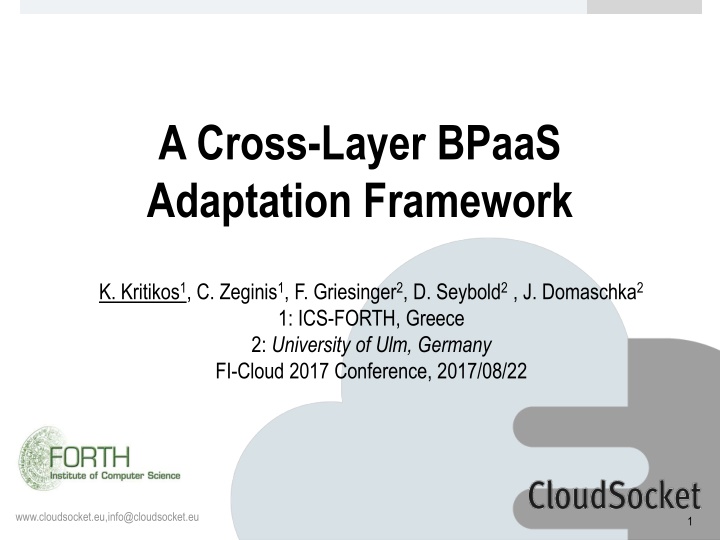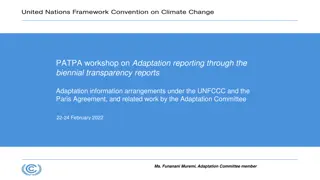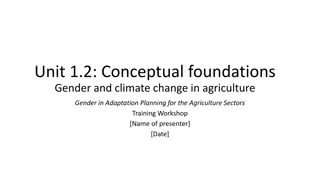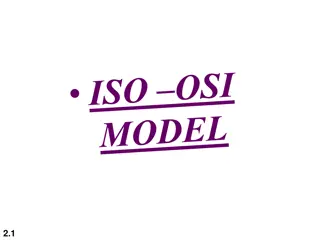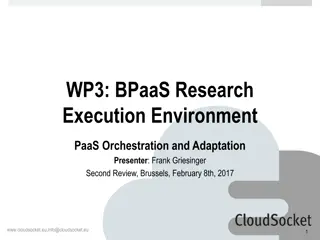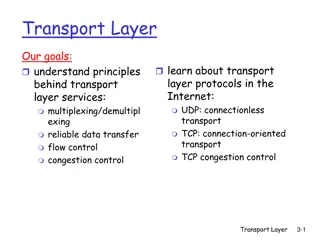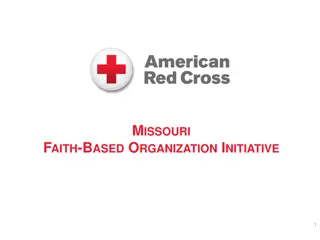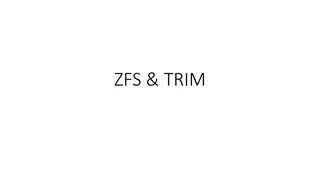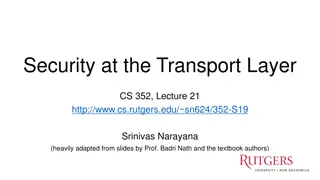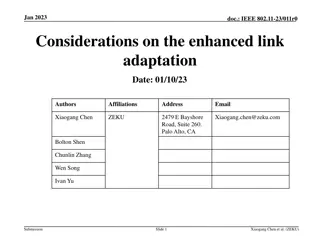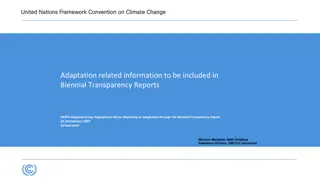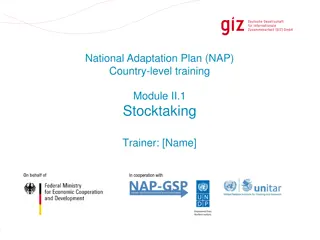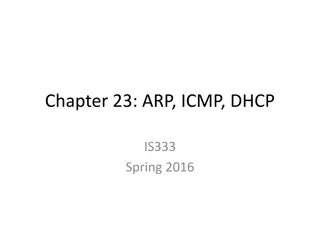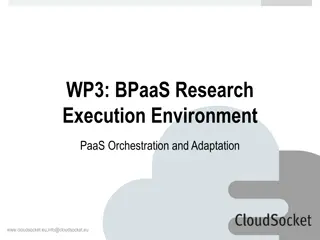A Cross-Layer BPaaS Adaptation Framework Overview
This framework addresses the problematic issues of flexibility and cost reduction in Business Processes as a Service (BPaaS) by monitoring and adapting BPaaS in a cross-layer manner. It focuses on handling the entire lifecycle of BPaaS and covers adaptation mechanisms for different layers in the cloud environment. The solution involves a model-based approach for aligning business processes with IT, provisioning BPaaS, and flexible metric specification through CAMEL for monitoring purposes. It also includes composition of existing adaptation frameworks to cover various layers and dynamic adaptation techniques for sustained service levels.
Download Presentation

Please find below an Image/Link to download the presentation.
The content on the website is provided AS IS for your information and personal use only. It may not be sold, licensed, or shared on other websites without obtaining consent from the author.If you encounter any issues during the download, it is possible that the publisher has removed the file from their server.
You are allowed to download the files provided on this website for personal or commercial use, subject to the condition that they are used lawfully. All files are the property of their respective owners.
The content on the website is provided AS IS for your information and personal use only. It may not be sold, licensed, or shared on other websites without obtaining consent from the author.
E N D
Presentation Transcript
A Cross-Layer BPaaS Adaptation Framework K. Kritikos1, C. Zeginis1, F. Griesinger2, D. Seybold2, J. Domaschka2 1: ICS-FORTH, Greece 2: University of Ulm, Germany FI-Cloud 2017 Conference, 2017/08/22 www.cloudsocket.eu,info@cloudsocket.eu 1
Outline Problematic Solution Overview & Architecture CAMEL Overview & Extensions Validation Future Work Directions www.cloudsocket.eu,info@cloudsocket.eu 2
Problematic Issues Flexibility & cost reduction in BPs via the cloud Business process as a Service (BPaaS) Need to handle whole lifecycle of BPaaS www.cloudsocket.eu,info@cloudsocket.eu 3
Problematic Issues Focusing on Execution activity, there exists the need to: Monitor & Adapt BPaaS in a cross-layer manner to sustain a certain service level Issues Many layers involved: IaaS, PaaS, SaaS, BPaaS Need for flexibility in metric specification & computation Need to realise layer-specific adaptation mechanisms Need to coordinate such mechanisms to deal with complex, problematic situations www.cloudsocket.eu,info@cloudsocket.eu 4
Problematic Related Work Analysis Our Solution www.cloudsocket.eu,info@cloudsocket.eu 5
Solution Overview Overall BPaaS Management: CloudSocket project Model-based approach for business-to-IT alignment & BPaaS provisioning Lifecycle activity-specific environments BPaaS Monitoring: Flexible metric specification via CAMEL [1] Distributed monitoring approach across layers & clouds CAMEL metric computation formulas/trees cover the measurability gap across layers & clouds www.cloudsocket.eu,info@cloudsocket.eu 6
Solution Overview BPaaSAdaptation: Composition of existing adaptation frameworks To cover all possible layers Pro- & re-active adaptation via: rule-based approach event correlation via execution history mining warning events semi-automatic production of adaptation rules Dynamic adaptation via concretisation & execution of abstract adaptation workflows specified in CAMEL Adaptation history recording & browsing www.cloudsocket.eu,info@cloudsocket.eu 7
Solution Architecture www.cloudsocket.eu,info@cloudsocket.eu 8
CAMEL Overview Multi-DSL focusing on capturing different domain-specific aspects of multi-cloud applications: Deployment, Requirement, Provider, Organisation, Location, Security, Metric, Scalability, Value Type, Unit Produced from existing languages (e.g., CloudML [2], Saloon [3]) & new ones (SRL [4]) Use of OCL rules for integration & semantic domain validation www.cloudsocket.eu,info@cloudsocket.eu 9
CAMEL Overview Based on Eclipse EMF Default tree-based editor Programmatic support Text-based editor for devops based on XText technology More details: www.camel-dsl.org www.github.com/camel-dsl: Meta-model Domain-code Text-based editor code www.cloudsocket.eu,info@cloudsocket.eu 10
CAMEL Overview Monitoring: Specification of metric (computation) trees Metric conditions Metric scheduling & measurement window Scalability Scalability rules mapping events to scaling actions Both horizontal & vertical scaling actions supported Events can be simple or composite Simple events map to metric conditions Composite events to event composition via temporal or logical operators www.cloudsocket.eu,info@cloudsocket.eu 11
CAMEL Extension Capability to specify complex adaptation actions instead of just scalability rules Simple actions (SimpleAdaptationTask) mapping to layer-specific adaptation capabilities Scale-in/out, Scale-up/down, Migration, Service Replacement, Workflow Recomposition, Task Add/Modify/Replace/Omit Composite actions (CompositeAdaptationTask) mapping to a combination of actions via well-known control-flow constructs Sequence, Parallel, Conditional, Switch Complex adaptation behaviour specified abstractly Freedom to choose from alternative implementations of layer-specific simple adaptation actions www.cloudsocket.eu,info@cloudsocket.eu 12
Validation Cross-Layer Adaptation Scenario www.cloudsocket.eu,info@cloudsocket.eu 14
Validation Initial Rule Set: R1: cpu_viol(i_ninja,send_invoice) hscale(i-ninja) R2: down(i_ninja,send_invoice) re-run (i-ninja) R2 covers non-permanent failures New rule is introduced by expert via CAMEL to handle permanent failures R3: down(i_ninja,send_invoice) failed(R2) seq(migrate(i_ninja), s_replace(i_ninja,send_invoice)) www.cloudsocket.eu,info@cloudsocket.eu 15
Future Work Thorough solution validation & testing Devise of sophisticated adaptation workflow concretisation algorithm Development of: New adaptation capabilities Alternative implementations of existing ones Dynamic injection of developed adaptation capabilities Adaptation history analysis www.cloudsocket.eu,info@cloudsocket.eu 16
References 1. A. Rossini, K. Kritikos, N. Nikolov, J. Domaschka, F. Griesinger, D. Seybold, D. Romero, D2.1.3 CloudML Implementation Documentation (Final version), PaaSage project deliverable, 2015. N. Ferry, A. Rossini, F. Chauvel, B. Morin, A. Solberg, Towards model-driven provisioning, deployment, monitoring, and adaptation of multi-cloud systems, in: L. O Conner (Ed.), Proceedings of CLOUD 2013: 6th IEEE International Conference on Cloud Computing, IEEE Computer Society, ISBN 978-0-7695-5028-2, 887 894, 2013. C. Quinton, D. Romero, L. Duchien, Cardinality-based feature models with constraints: a pragmatic approach, in: T. Kishi, S. Jarzabek, S. Gnesi (Eds.), SPLC 2013: 17th International Software Product Line Conference, ACM, 162 166, 2013 K. Kritikos, J. Domaschka, A. Rossini, SRL: A Scalability Rule Language for Multi- cloud Environments, in: CloudCom, IEEE, 1 9, 2014. 2. 3. 4. www.cloudsocket.eu,info@cloudsocket.eu 17
